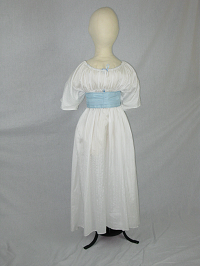1804
Cotton, long denied the middle class, became less expensive and more available by the early 19th century. This sheer white muslin day dress shows evidence of the Greek and Roman influence. The classical silhouette with its high waist and column-like skirt was triggered by the finds of Pompeii. The bodice and half sleeves are lined. Heavily gathered in the back, the skirt ends in a short train. This style of gown had been popular for children since 1780, but with a wide colored sash and no train, so girls of that generation grew up experiencing little change in fashion. Up until this time, children were dressed as little adults, but by the 19th century, new fashion styles were sometimes put on children first before the style was worn by adults.
Grecian style necklace and bracelets complement the classic look. The short and curly hair style became fashionable when the hair of the nobles was cut during the French Revolution before they were taken to the guillotine. The classical toga was doomed to limited success; its bare throats and legs might have been fashionable, but the transparent muslin offered no protection from cold drafts in the cooler northern climates. Buttons were still considered masculine, so this bodice front is held in place with straight pins. Stays were discarded, but support was achieved by an extra vest fastened with straight pins beneath the bust. By 1800 undergarments consisted of a knee-length chemise with short sleeves. Elastic drawers, of knitted cloth, appeared in 1806, and were considered a status symbol, worn only by the very rich and considered immodest by matrons. It was said that the sheerness of these dresses made the legs blush, so pink stockings were often worn. Sandals were the style; some laced up the legs with ribbons.
The English and Americans accepted the near nudity of French fashions with moderation. Some stays or corsets were discarded by the fashionable, but returned early in the new century. The chemise was no longer called a shift and has shortened to knee length. Many had a bodice of coarser material tied or pinned across the front which substituted for the corset.
A long shawl is meant to keep off the draft. The draping of the figure with a long shawl became popular when Napoleon’s soldiers brought back cashmere shawls from their campaigns across the Mediterranean world and central Asia. These many colored woolen shawls helped chase the chill but were expensive, costing as much as $10,000. Josephine was said to have over 100. Napoleon did not like them and kept throwing them in the fire. English paisley printed copies were introduced and the lace kerchief of the earlier period evolved into long narrow shawls. Long gloves were worn with short sleeves.
Click photo for detailed view.


